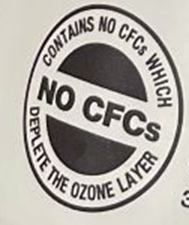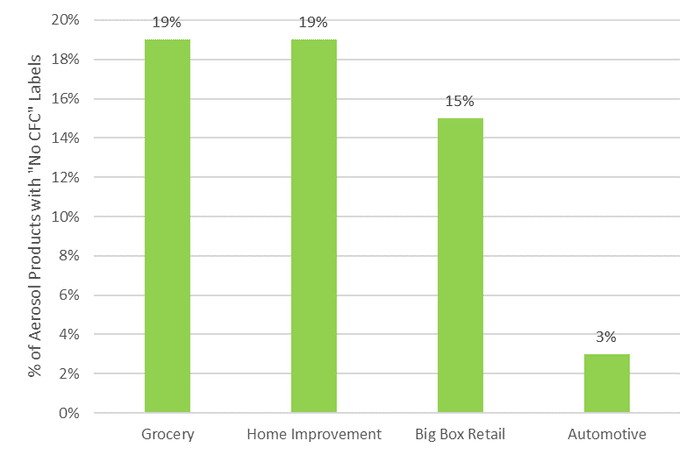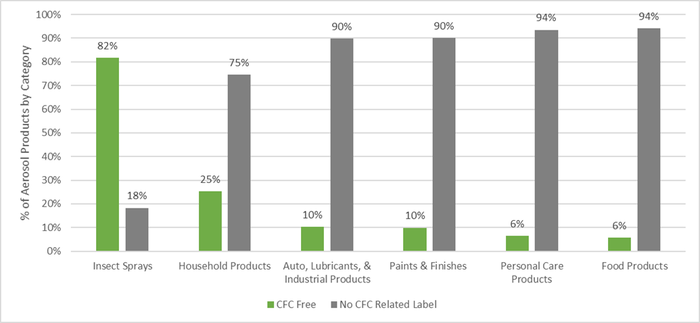Despite CFCs Being Banned for Decades from Consumer Products, “CFC Free” Labeling Remains Common
In 1994, with the issuance of U.S. EPA’s Pesticide Regulation Notice (PRN) 93-4, CFCs were effectively banned in pesticides and other consumer aerosol products. Following that new regulation, all consumers aerosols must be CFC free.
In the 1970s, when researchers discovered that CFCs triggered a chain reaction that destroyed the ozone layer (read previous article), they were widely used across the globe in refrigeration systems, as well as in consumer aerosol products like hairspray or bug sprays (pesticides), and spray paints. This discovery triggered many CFC product manufacturers to begin phasing out its use and to seek alternatives. It even spurred many developed nations to create legislation that would phase out and ultimately ban CFC use, via the Montreal Protocol. The late 1970s to the mid-1990s represented a period in the U.S. where certain consumer products may or may not have contained CFCs, so aerosol manufacturers began adding “No CFCs” labeling on their products.

Example of a “No CFCs” Label on an Aerosol Product.
It’s been over 30 years since this legislation went into effect, so one might expect “No CFCs” labeling to have disappeared, much like the hole in the ozone layer, right? Recently, the Environmental Research & Education Foundation (EREF) conducted a study on consumer environmental labeling of aerosol products at grocery, big box, automotive, and home improvement stores across the nation. This work included an assessment of whether or not aerosols still displayed a “No CFCs” label. The results show that use of these labels is still alive and well. In fact, of the nearly 4,500 aerosol products catalogued, over 17% were branded “No CFCs.”
The figure below shows that grocery and home improvement stores had the largest prevalence of aerosol products with “No CFCs” labeling, followed closely by big box retail stores. On the other hand, automotive stores had a very low prevalence of aerosols with this labeling. Given the large percentage of the U.S. population who routinely shops at grocery, home improvement, and big box retail stores, consumers purchasing aerosol products are highly likely come across “No CFCs” labeling.

Prevalence of “No CFCs” Labeling on Aerosol Products at Different Retail Store Types.
EREF also compared the types of aerosol products. The figure below highlights that insect sprays (i.e. pesticides) have a 3-fold higher prevalence of “No CFCs” labeling compared to household products (e.g. disinfectants, laundry products, cleaners, air fresheners) and over 8 times more compared to all other product types.

Prevalence of “No CFCs” Labeling on by Product Category.
Since the mid-90s issuance of EPA PRN 93-4 was specific to the banning of CFCs in pesticide aerosol products, “No CFCs” labeling is, essentially, unnecessary. It’s on par with Coca Cola labeling its products “No Cocaine” even though it’s been over a century since its inclusion. So, why would products still contain these labels decades later? While there may still be some legitimate reasons to have such a label, these justifications would make far more sense for non-consumer CFC-containing products (such as some refrigerants) that are still being phased out.
While speculative, product manufacturers might still feel that such labeling offers differentiation from a marketing standpoint. This perspective could play off a couple of factors: (1) the decrease in use of “No CFCs” labeling due to it being unnecessary, and (2) consumer ignorance.
First, the labels are far less prevalent than they were in the 1990s, despite still being around. Still, the unnecessary use of this branding could lead unaware consumers to believe that they’re making a better environmental choice by purchasing “No CFCs” products. If this were the case, this branding is nothing more than a form of greenwashing. Conversely, consumers who are aware but perhaps not well-educated on the CFC issue may feel products without “No CFCs” branding are not environmentally responsible, which puts product manufacturers in a tough spot. Such issues highlight how, in addition to sound science, strong consumer education is a necessary ingredient to advance sustainability.
About the Author
You May Also Like




